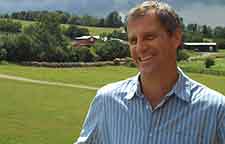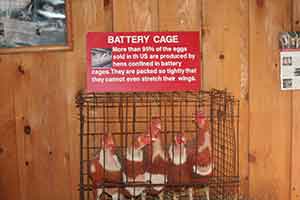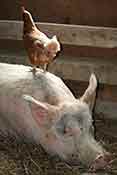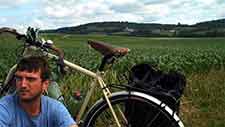Farm Sanctuary, Watkins Glen, New York
There is a war between several animal rights organizations and modern industrial agriculture. This battle is political and personal and it is spilling out into America’s mainstream media outlets. On the front lines of the animal rights movement is Gene Baur, founder of the Farm Sanctuary in Watkins Glen, New York.
For me, getting to the Farm Sanctuary was no easy task. My sushi and sake–fueled escapades the night before in Ithaca had rewarded me with a massive headache, dehydration, and nausea. The humidity and wind was relentless and for several hours and only 24 miles I struggled on my bike across the peaks and valleys of the Finger Lakes region.
Before I’d started this journey, countless people asked if I was scared to climb the Rocky and North Cascade Mountain Ranges. I simply told them no, because I imagined by the time I would reach the western half of the country, I’d be in stellar condition both physically and mentally. But nobody, not one person had ever mentioned the Finger Lakes. (I would later find myself slowly crawling up steep hills for 40 minutes only to zoom down the other side in 40 seconds the entire stretch between Ithaca, New York, and Erie, Pennsylvania.)
I caught a break when my Twitter friends in Ithaca put me in touch with Sarah Freeman (@SarahAFreeman). Sarah’s parents own a beautiful, quaint cottage on Seneca Lake just a few miles north of Watkins Glen, and she offered me the cottage for two nights. To celebrate arriving in downtown Watkins Glen (and to taste the hair of the dog that bit me) I made a pit stop at the Rooster Fish Brewery.
I sat at the bar and over small talk I told the young and skinny bartender that I was staying just 6 miles north of town. When I mentioned I was looking for Hunt Road he looked at me askance and said, “Dude, you know you have to climb for 6 miles right?” Thinking back on the day of brutal hills and relentless weather I replied, “I don’t think it matters at this point.” He just smirked and continued talking about the big race that weekend; NASCAR is an informal religion in Watkins Glen.
After I finished my cold brew, I climbed back on my bike. Just as I started pedaling uphill, a thunderstorm descended and pounded me with heavy rain. I had had enough. Of everything. I found the nearest shelter under the awning of a large building. I was soaking wet and feeling defeated when a man opened a door and asked, “Can I help you with something?” I explained my predicament, and he ducked back inside. When he returned, he was carrying a glass of red wine. Moments later the rain subsided and I took a look at my surroundings. I had found shelter at one of the Finger Lakes trademark vineyards.
As serendipity would have it, a rainbow appeared over the grape vines perfectly aligned on a hillside. It’s funny how things can change in life…and sometimes all you need is fifteen minutes.
Now back to the Farm Sanctuary.
Coincidentally, the Farm Sanctuary’s roots lie deep in my hometown, Lancaster, Pennsylvania. In 1986, during a visit to the Lancaster Stockyards to document the conditions of the facility and the treatment of animals, Gene Baur discovered his passion for rescuing animals and the Farm Sanctuary was born.
During a conversation with Gene about his visit to my hometown, he described what he found as “appalling”. Animals were lying around the stockyards, left for dead. One animal in particular, later named Hilda, a sheep still alive and lying helpless on a pile of rotting animal carcasses was rescued.
Since 1986, the Farm Sanctuary has rescued thousands of animals like Hilda, where they are brought to one of two Farm Sanctuary locations: A 175-acre shelter in upstate New York, near Watkins Glen, or a 300-acre shelter in Northern California. The rescued animals are given an opportunity to live a carefree life with spacious living and expert medical attention. Later the animals are either adopted through the Farm Sanctuary’s strict Farm Animal Adoption Network or they will live out their days on the sanctuary.
When Farm Sanctuary started, it was a fledgling, all-volunteer organization that was funded by sales of veggie hot dogs from a Volkswagen van. Today, Farm Sanctuary has grown into the nation’s leading farm animal protection organization, with hundreds of thousands of supporters.
As I pedaled away from the cozy cottage and 16 miles to the farm, I thought of the irony of me rolling into an animal rights organization seated on my genuine leather bike saddle. Whether anyone noticed, I am not sure.
In the Farm Sanctuary lobby, endless facts about the so called “factory farming” industry are posted on the walls. On display are crates and cages commonly used in confined animal farming operations (CAFOs). There are gestation crates, which are used to prevent breeding pigs from roaming, spending years boxed up with minor breaks for pregnancy and birth. Battery cages in which chickens are crammed so tightly that they cannot even spread their wings are mounted on the wall. These same cages are used in 90% of our nation’s egg production. The Farm Sanctuary lobby is full of big fat reminders the general public has simply learned to forget while browsing the aisles at the supermarket.
I got lucky during my visit to the Farm Sanctuary. In a slim window between promoting his new book titled Farm Sanctuary: Changing Hearts and Minds About Animals and Food and his advocacy work, Gene Baur happened to be in Watkins Glen. When staff member Michelle King of nearby Trumansburg informed Gene of my interview request, he gladly accepted.
Gene and I exchanged small talk and walked outside to find the perfect spot for my video camera to capture a picturesque backdrop. As I admired the lush green pasture, red barn, and round hay bales, Gene Baur began delivering an endless flow of powerful commentary.
When I asked him about the mission of the Farm Sanctuary he dove in without pausing,
“We encourage people to make food choices that are consistent with their own values and consistent with their own interest. I think that for most people that means not buying factory-farmed meat, milk, and eggs and for many people I think that would mean not eating animals altogether. Killing animals is an inherently violent act and most people are not comfortable looking at it. If most people are not comfortable looking at it then I think they should reevaluate whether or not they want to support it.”
There is no question that the realities of slaughtering animals are painful to acknowledge, much less witness. For millions of people those facts are reason enough to stop eating meat. But dedicating your life to running an animal rights organization is taking it to a whole new level. What was the incredible driving force that steered Gene to start the Farm Sanctuary? “When I grew up I always wanted to do something good. I didn’t want to just get a job and make a lot of money, which is what I was encouraged to do, just like most people are encouraged to do growing up in America. As time went I got involved in children, environmental, and animal organizations. I started recognizing that the industrial animal farming industry was creating negative consequences for every group that I was concerned about.” Gene said with perfect delivery.
So, I wondered, how exactly does an activist on a mission create a nonprofit entity with two locations with nearly 500 acres of land and more than 200,000 members?
“When you do this work you will come across some of the most dedicated people you will ever imagine,” said Gene. “Ultimately, the people who really care are the ones who lead us to make a difference. Sometimes people get very apathetic and come to accept bad things as normal. Those people who support the Farm Sanctuary are those who believe that things can be different and that things can be better. They are willing to put their time and their resources behind this effort and for that we are very thankful for them.”
Gene continued. “Agribusiness is very influential and we face tremendous challenges when we are trying to pass laws through the legislative process. What we have done instead is started going through the initiative process where voters get a chance to decide these issues. Thankfully when people have a chance to vote and to decide whether or not it is okay for animals to be treated the way that they are in today’s farms, most citizens think there needs to be change and these animals need to be treated better. Right now farm animals are being treated very badly and in a way that most people would be appalled by.”
Makes you want go out and grab a burger, doesn’t it?
Gene’s words were brash and assertive, and they nearly had me ready to give up my favorite ham and eggs for breakfast. Staring at the rain clouds moving in, I indicated that I was ready to wrap up the interview. Gene, however, had a good sound bite locked and loaded. Before I could reach over and turn my camera off he blurted,
“Our food choices have profound consequences, but most people don’t think very much about their food choices and are eating in a way that is harmful to themselves, harmful to the animals, and harmful to the planet and is inconsistent with their own values and inconsistent with their own interest.”
I could tell Gene sensed that his message was getting dark, and he quickly changed his tone before adding,
“With the internet there are great opportunities for people to learn and share information. There is currently a movement where people are learning more and are concerned about the inhumane treatment of animals and the health and environmental issues that are resulting from factory farming Thankfully, right now there is a movement towards farmers’ markets and community supported agriculture [CSA] and people getting connected with their food.”
Gene and millions of other Americans know that we have turned food production into one large assembly line. As I thought about our interview, I reflected on the real reason I busted my hump in the pouring rain to visit the Farm Sanctuary. I wanted to hear Gene Baur offer me a solution to this current epidemic. Sure, I had seen Food, Inc. and read The Omnivore’s Dilemma. But I was talking to a foot soldier in the war on food. This face time was something I couldn’t find in a book or on a DVD,
Gene gave me a good, hard stare and said,
“Just like bad things that spread, good things can spread. Human beings are very social animals and we tend to do what those around us do. When bad and cruelty is the norm, somehow it becomes accepted and it is often unjust and people of consciousness need to speak up.”
And with that, Gene Baur shook my hand and walked away.
That night I returned to the lakeside cottage where there rhetoric of Gene Baur ran through my mind. I realized his words and passion had touched me in a way that would change how I value my consumption of food from animals altogether. I felt sadness thinking how as a species we have clinically removed millions of other animals from their natural environments where they were meant to connect, learn from, and share with Mother Nature.
It hurt to realize that much of our food production involves little to no dignity to the innocent animals being killed in facilities, and that we no longer celebrate nor are we grateful for the animals that fuel us. We allow corporate food giants to get rich creating enough triple bacon cheeseburgers to feed the world while the human species slowly amuses itself to death.
I had no intention of becoming a vegetarian, vegan, or any other type of labeled eater. What I found in Watkins Glen was a belief that we can all find more common ground in this world if we stop labeling ourselves and begin to educate ourselves collectively through an honest and transparent approach to the production of food.
As the sun set over the sparkling waters of Seneca Lake and spun a gradient of deep blues, purples, and red into the darkening sky, I sat back, elevated my feet, took a long draw from my glass of red wine and smiled knowing that I had no reason to be sad. I had made a choice: to become part of the industrial food solution and not the problem.
Read the Unconventional Harvest series:
- On the Road to Find the Future of Food and Farming
- Grassland Organic Farm
- Wellspring Farm
- My Visit to an Amish Farm in New York
- Farm Sanctuary
- An Urban Oasis for Food
- Tantré Farm
- Conventional Dairy Farmer Art Thelen
- New Forest Farm
- A Large No-Till Organic Farm
- Melstone, Montana—Population 136
- In the Farmers Own Words
Nathan Winters rode a bicycle across America to discover first-hand why our food system had grown to be unsustainable, and to find alternative solutions. He traveled into the homes and communities of organic, conventional, urban and Amish farmers and community organizers. This ongoing series—to be posted every other Wednesday— represents select material from The Unconventional Harvest, a work in progress, by Nathan A. Winters.






